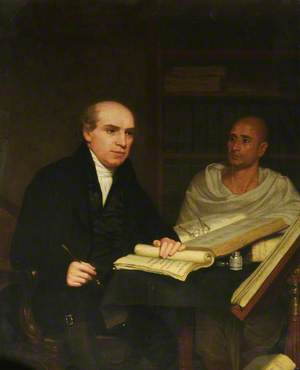William Carey (1761-1834) and his Indian pundit Mrityunjaya Vidyalankar (c. 1762-1819)
Artist: Robert Home (1752-1834)

William Carey was born on 17th August 1761 at Paulerspury, Northamptonshire. Carey is perhaps most well-known for his contributions to Bible translation and language study; he was well versed in Latin, Greek, Hebrew, Bengali, Sanskrit and Marathi. Carey also had a deep interest in the world beyond Europe, an interest awakened by his reading of the published accounts of the south sea voyages of Captain James Cook, which also burgeoned a life-long dedication to missionary work. Amongst the earliest members of the Baptist Missionary Society were the “Serampore Trio”, including Carey, William Ward, and Dr Joshua Marshman, who also went on to found the ecumenical Serampore College, outside Kolkata in north-east India, for educating local people and training ministers for India’s Christian Church. Alongside his pundits, principally Mrityunjaya Vidyalankar, a revered Sanskrit scholar and an artist of Bengali prose, Carey translated the Bible into six languages – Bengali, Oriya, Sanskrit, Hindi, Marathi, and Assamese – and sections of it in an additional 29 languages. Both Carey and Vidyalankar were commended for their contributions to the field of Bible translation; in Carey’s funeral sermon, John Mack reflected: “To give the scriptures to men in their own tongue in which they were born, is to impart to them the most precious boon which God has bestowed on our race”.
None of this could have happened if it wasn’t for Carey’s first wife, Dorothy Carey. Upon Carey’s first mission to Bengal in 1793, Dorothy was left with no choice but to uproot her life and leave the comforts of Northamptonshire to support her husband. The move greatly affected Dorothy, who suffered considerably from mental illness until she died in 1807. Indeed, H. McBeth notes, “Somewhere in missionary history, a word of compassion should be written for Dorothy Carey, who paid a high price for the Baptist missions”; and that somewhere is contained within this plaque.